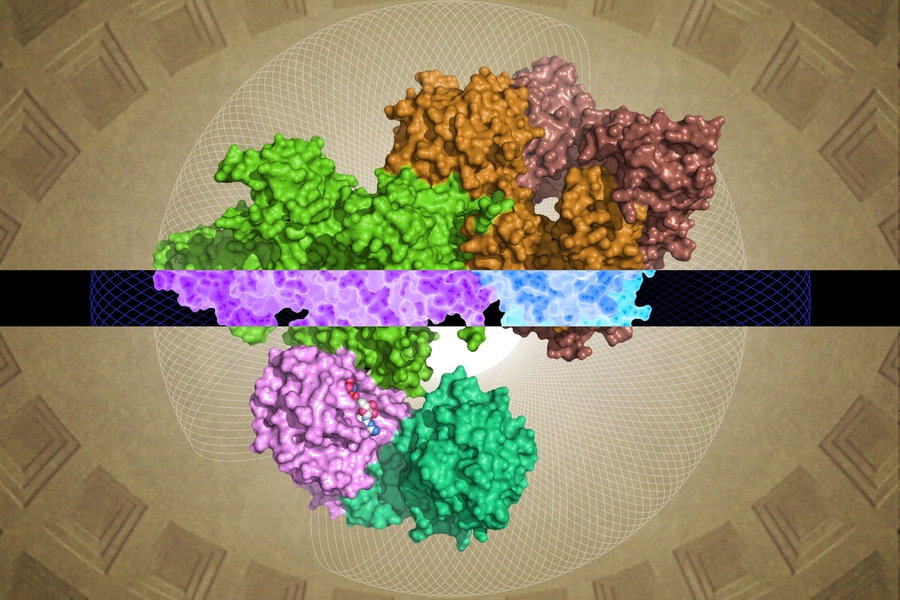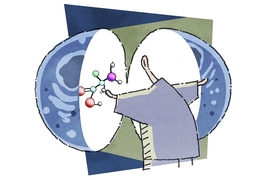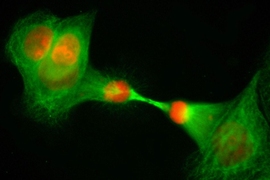A team of researchers from Whitehead Institute and the Howard Hughes Medical Institute has revealed the structure of a key protein complex in humans that transmits signals about nutrient levels, enabling cells to align their growth with the supply of materials needed to support that growth. This complex, called GATOR1, acts as a kind of on-off switch for the “grow” (or “don’t grow”) signals that flow through a critical cellular growth pathway known as mTORC1.
Despite its importance, GATOR1 bears little similarity to known proteins, leaving major gaps in scientists’ understanding of its molecular structure and function. Now, as described online on March 28 in the journal Nature, Whitehead scientists and their colleagues have generated the first detailed molecular picture of GATOR1, revealing a highly ordered group of proteins and an extremely unusual interaction with its partner, the Rag GTPase.
“If you know something about a protein’s three-dimensional structure, then you can make some informed guesses about how it might work. But GATOR1 has basically been a black box,” says senior author David Sabatini, a member of Whitehead Institute, a professor of biology at MIT, and investigator with the Howard Hughes Medical Institute (HHMI). “Now, for the first time, we have generated high-resolution images of GATOR1 and can begin to dissect how this critical protein complex works.”
GATOR1 was first identified about five years ago. It consists of three protein subunits (Depdc5, Nprl2, and Nprl3), and mutations in these subunits have been associated with human diseases, including cancers and neurological conditions such as epilepsy. However, because of the lack of similarity to other proteins, the majority of the GATOR1 complex is a molecular mystery. “GATOR1 has no well-defined protein domains,” explains Whitehead researcher Kuang Shen, one of the study’s first authors. “So, this complex is really quite special and also very challenging to study.”
Because of the complex’s large size and relative flexibility, GATOR1 cannot be readily crystallized — a necessary step for resolving protein structure through standard, X-ray crystallographic methods. As a result, Shen and Sabatini turned to HHMI’s Zhiheng Yu. Yu and his team specialize in cryo-electron microscopy (cryo-EM), an emerging technique that holds promise for visualizing the molecular structures of large proteins and protein complexes. Importantly, it does not utilize protein crystals. Instead, proteins are rapidly frozen in a thin layer of vitrified ice and then imaged by a beam of fast electrons inside an electron microscope column.
“There have been some major advances in cryo-EM technology over the last decade, and now, it is possible to achieve atomic or near atomic resolution for a variety of proteins,” explains Yu, a senior author of the paper and director of HHMI’s shared, state-of-the-art cryo-EM facility at Janelia Research Campus. Last year’s Nobel Prize in chemistry was awarded to three scientists for their pioneering efforts to develop cryo-EM.
GATOR1 proved to be a tricky subject, even for cryo-EM, and required some trial-and-error on the part of Yu, Shen, and their colleagues to prepare samples that could yield robust structural information. Moreover, the team’s work was made even more difficult by the complex’s unique form. With no inklings of GATOR1’s potential structure, Shen and his colleagues, including co-author Edward Brignole of MIT, had to derive it completely from scratch.
Nevertheless, the Whitehead-HHMI team was able to resolve near-complete structures for GATOR1 as well as for GATOR1 bound to its partner proteins, the Rag GTPases. (Two regions of the subunit Depdc5 are highly flexible and therefore could not be resolved.) From this wealth of new information as well as from the team’s subsequent biochemical analyses, some surprising findings emerged.
First is the remarkable level of organization of GATOR1. The protein is extremely well organized, which is quite unusual for proteins that have no predicted structures. (Such proteins are usually quite disorganized.) In addition, the researchers identified four protein domains that have never before been visualized. These novel motifs — named NTD, SABA, SHEN, and CTD — could provide crucial insights into the inner workings of the GATOR1 complex.
Shen, Sabatini, and their colleagues uncovered another surprise. Unlike other proteins that bind to Rag GTPases, GATOR1 contacts these proteins at at least two distinct sites. Moreover, one of the binding sites serves to inhibit — rather than stimulate — the activity of the Rag GTPase. “This kind of dual binding has never been observed — it is highly unusual,” Shen says. The researchers hypothesize that this feature is one reason why GATOR1 is so large — because it must hold its Rag GTPase at multiple sites, rather than one, as most other proteins of this type do.
Despite these surprises, the researchers acknowledge that their analyses have only begun to scratch the surface of GATOR1 and the mechanisms through which it regulates the mTOR signaling pathway.
“There is much left to discover in this protein,” Sabatini says.
This work was supported by the National Institutes of Health, Department of Defense, National Science Foundation, the Life Sciences Research Foundation, and the Howard Hughes Medical Institute.










